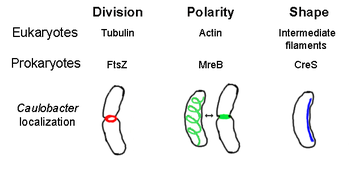Prokaryotic cytoskeleton
MreB assembles into a helical network of filamentous structures just under the cytoplasmic membrane, covering the whole length of the cell.[14] ParM is a cytoskeletal element that possesses a similar structure to actin, although it behaves functionally like tubulin.ParM affixes to ParR, a DNA-binding protein that specifically binds to 10 direct repeats in the parC region on the R1 plasmid.[17] Lately an actin-like ParM homolog has been found in a gram-positive bacterium Bacillus thuringiensis, which assembles into a microtubule-like structure and is involved in plasmid segregation.[18] Crenactin is an actin homologue unique to the archaeal kingdom Thermoproteota (formerly Crenarchaeota) that has been found in the orders Thermoproteales and Candidatus Korarchaeum.The MinCDE helix occupies a pole and terminates in a filamentous structure called the E-ring made of MinE at the middle-most edge of the polar zone.[24] The dynamic behavior of the Min proteins has been reconstituted in vitro using an artificial lipid bilayer as mimic for the cell membrane.[25] Bactofilin (InterPro: IPR007607) is a β-helical cytoskeletal element that forms filaments throughout the cells of the rod-shaped proteobacterium Myxococcus xanthus.
Caulobacter crescentusfilamentsprokaryotesanalogueseukaryotescell divisionactin-myosin contractile ringseptumcytokinesistubulinprimary structuresmonomeric tubulin dimerizationantibioticsEscherichia coliprimary structurecytoplasmic membranepeptidoglycandynamic instabilityR1 plasmidDNA-binding proteinmitotic spindlekinetochorecentromerechromosomeF plasmidgram-positiveBacillus thuringiensisplasmidarchaealThermoproteotaThermoprotealesCandidatus KorarchaeumAsgardarchaeotaprofilingelsolincofilinCrescentinintermediate filamentscytokeratin 19nuclear lamin AMin systemInterProrod-shapedMyxococcus xanthusProteus mirabilisHelicobacter pyloriCyanobacterial morphologyCytoskeletonProtein filamentBibcodebioRxivProteinsMicrofilamentsMyofilamentActinsMyosinsMYO15AMYO18AMYO18BTropomodulinTroponinTropomyosinActininArp2/3 complexactin depolymerizing factorsDestrinWiskott–Aldrich syndrome proteinFibrillinFilaminTRIOBPKeratinCytokeratinEpithelial keratinstype Ichromosome 17chromosome 12type IIHair keratinsBeta-keratinDesminPeripherinVimentinInternexinNestinNeurofilamentSyneminSyncoilinNuclear laminsMicrotubulesTubulinsTUBA1ATUBA1BTUBA1CTUBA3CTUBA4ATUBB2ATUBB2CTUBGCP2TUBGCP3TUBGCP4TUBGCP5TUBGCP6KinesinsKIF13AKIF13BKIF16BKIF18AKIF18BKIF20AKIF20BKIF21AKIF21BKIF26ADyneinsDNAH11DYNC1H1DYNC2H1DYNC1I1DYNC1I2DYNC1LI1DYNC1LI2DYNLL1DYNLL2DYNLRB1DYNLT1